 There are so many things to see in the garden, too many to share. This is a glimpse of what is going on now. Enjoy the view!
There are so many things to see in the garden, too many to share. This is a glimpse of what is going on now. Enjoy the view!









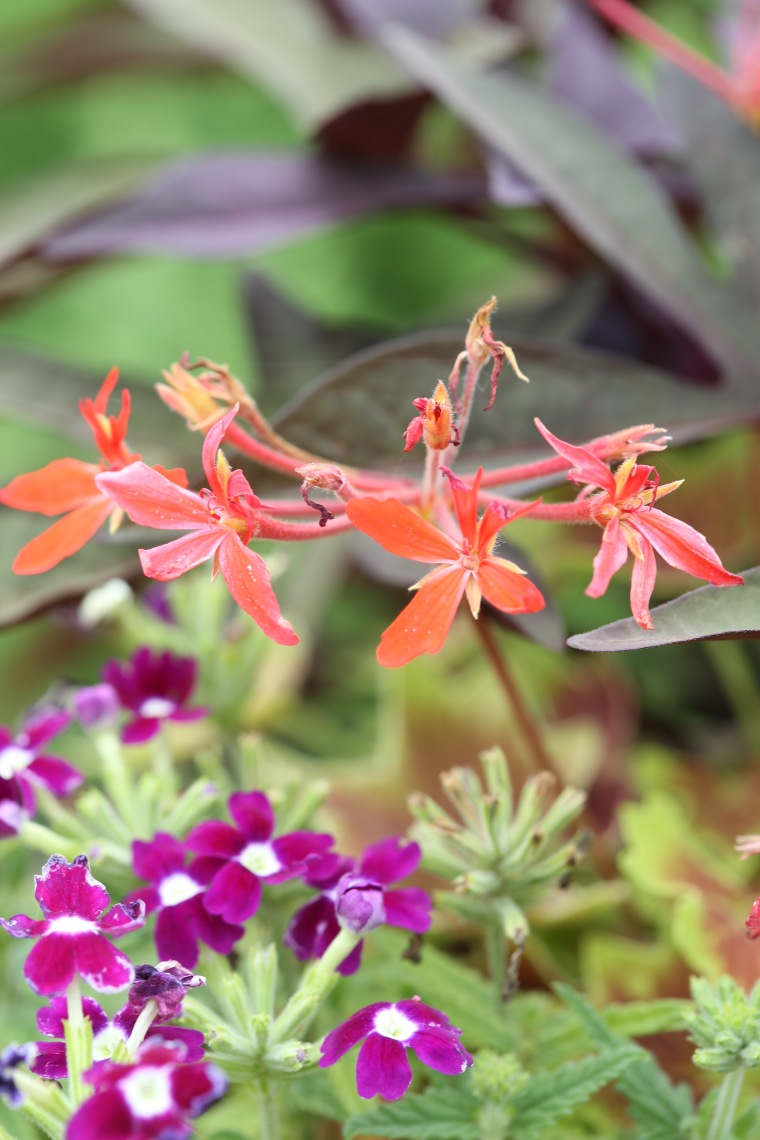

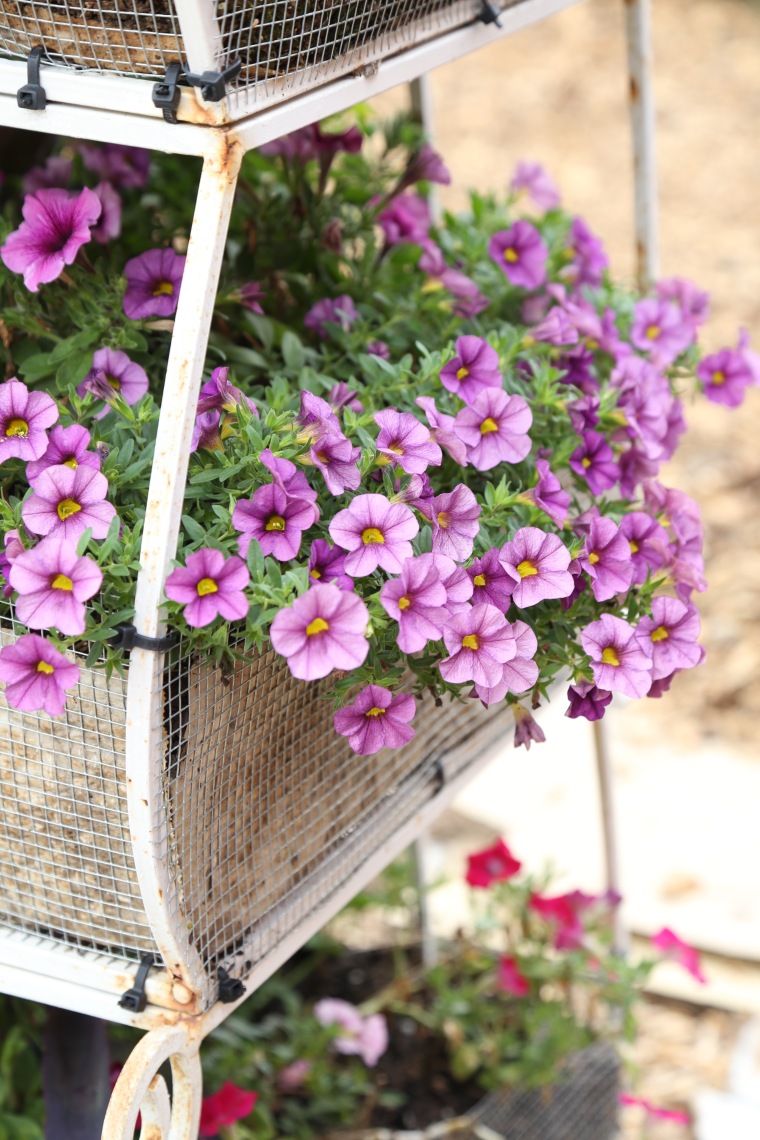










 There are so many things to see in the garden, too many to share. This is a glimpse of what is going on now. Enjoy the view!
There are so many things to see in the garden, too many to share. This is a glimpse of what is going on now. Enjoy the view!






















 To say it has been cold here is an understatement. Yes, I know that plenty of places are much colder and covered in snow, so what! We moved south to escape snow and frigid temperatures and the last two weeks have been brutal here. So rather than dwell on the cold or debate who has it worse and all that, let’s just look at photos from the fall taken out at the Demonstration Garden in Ellington Ag Center. Before the frost. When it was still warm… Mexican Sage in bloom.
To say it has been cold here is an understatement. Yes, I know that plenty of places are much colder and covered in snow, so what! We moved south to escape snow and frigid temperatures and the last two weeks have been brutal here. So rather than dwell on the cold or debate who has it worse and all that, let’s just look at photos from the fall taken out at the Demonstration Garden in Ellington Ag Center. Before the frost. When it was still warm… Mexican Sage in bloom. Love the fuzzy blooms, so do the bees.
Love the fuzzy blooms, so do the bees.
 Vietnamese coriander in bloom. So delicate and tiny.
Vietnamese coriander in bloom. So delicate and tiny. The swamp monster that tried to eat the garden-Swamp sunflowers in bloom
The swamp monster that tried to eat the garden-Swamp sunflowers in bloom
 The swamp sunflowers were about 8 feet tall and they are spreading out. Don’t they look beautiful with the Burning Bushes?
The swamp sunflowers were about 8 feet tall and they are spreading out. Don’t they look beautiful with the Burning Bushes?
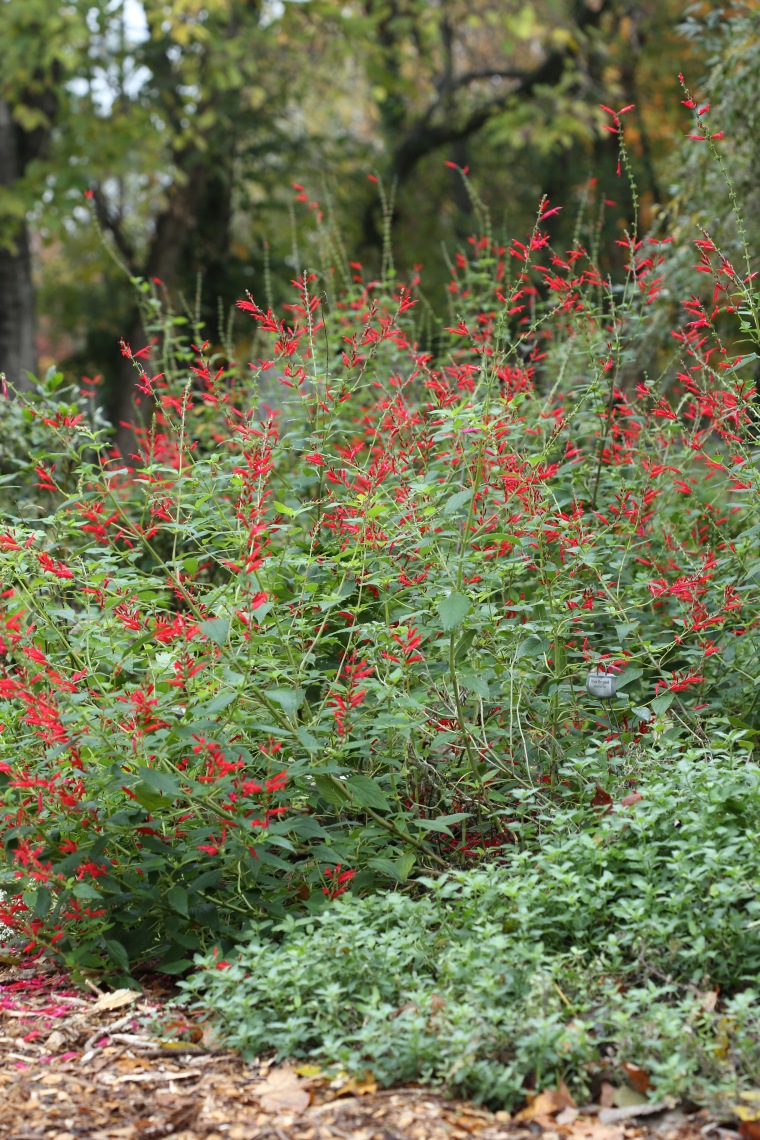 Want to plant something that bees and hummingbirds love? Fill your garden with salvias and one of my favorites is Pineapple Sage. The leaves smell like a pineapple lifesaver candy when you rub them and they are edible meaning you can use them as you would most other edible herbs. Honey bees love them and if you have a colony nearby, you might just find enough of them in it to make the whole plant buzz and vibrate. Hummingbirds will visit them too but only if they stay in your area through the fall. Pineapple sages tends to put this show on late in the season and this was taken around the first week of November.
Want to plant something that bees and hummingbirds love? Fill your garden with salvias and one of my favorites is Pineapple Sage. The leaves smell like a pineapple lifesaver candy when you rub them and they are edible meaning you can use them as you would most other edible herbs. Honey bees love them and if you have a colony nearby, you might just find enough of them in it to make the whole plant buzz and vibrate. Hummingbirds will visit them too but only if they stay in your area through the fall. Pineapple sages tends to put this show on late in the season and this was taken around the first week of November.
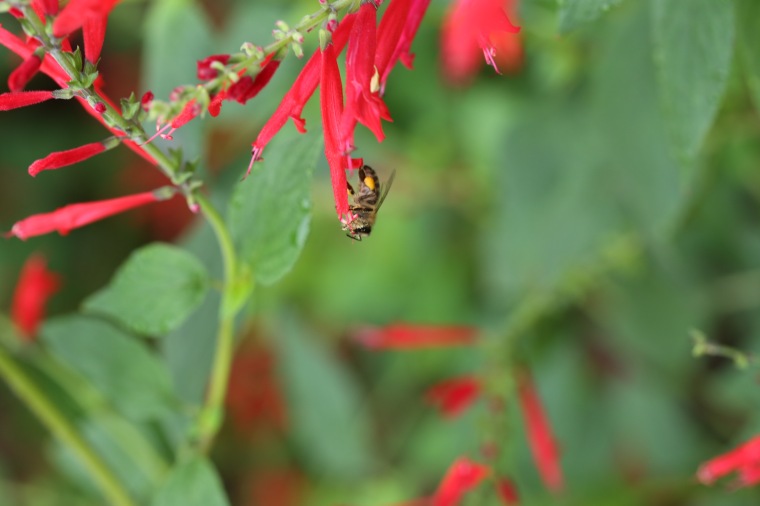 Just look at those pollen baskets!
Just look at those pollen baskets!
 We built this out at the Bee Garden and we are hoping that beneficial insects are nesting here.
We built this out at the Bee Garden and we are hoping that beneficial insects are nesting here.

 This garden is just full of color and blooms.
This garden is just full of color and blooms.
 Our climate here allows for tropical plants to grow and thrive during the warmer months but the fruit never has a chance to mature and ripen.
Our climate here allows for tropical plants to grow and thrive during the warmer months but the fruit never has a chance to mature and ripen.
 We can only dream about bananas; these did not make it and were killed by frost shortly after I took the photos but while it was blooming, the wasps and bees loved the nectar and pollen.
We can only dream about bananas; these did not make it and were killed by frost shortly after I took the photos but while it was blooming, the wasps and bees loved the nectar and pollen.
 Isn’t it wonderful when several of your favorite things come together? Everyone who visits this blog knows I love to garden and that baking is what I do professionally. But I am betting that not many of you know that I have a thing for hibiscus plants, specifically, Hibiscus sabdariffa. More commonly known as Roselle, this is the variety of hibiscus used to make tea. Just look at that bloom; how could you not love it?
Isn’t it wonderful when several of your favorite things come together? Everyone who visits this blog knows I love to garden and that baking is what I do professionally. But I am betting that not many of you know that I have a thing for hibiscus plants, specifically, Hibiscus sabdariffa. More commonly known as Roselle, this is the variety of hibiscus used to make tea. Just look at that bloom; how could you not love it?
 While the flower is pretty, and edible, it is a day flower which means it opens for a day and then dies. As soon as the bloom withers, the plant begins producing seeds in the calyx. To make tea, you must gather them before the pod swells with immature seeds. It takes quite a few to make a pot of tea! Because of this, I generally plant 3 or 4 of them around the garden and yard. They can get quite large if the conditions are right; lots of direct sun, plenty of moisture but not soggy.
While the flower is pretty, and edible, it is a day flower which means it opens for a day and then dies. As soon as the bloom withers, the plant begins producing seeds in the calyx. To make tea, you must gather them before the pod swells with immature seeds. It takes quite a few to make a pot of tea! Because of this, I generally plant 3 or 4 of them around the garden and yard. They can get quite large if the conditions are right; lots of direct sun, plenty of moisture but not soggy.
 If you are looking at this plant and are thinking that it looks like okra, you are right! Hibiscus is also related to cotton and if you spend time in garden centers, you will find that there are lots of perennial and annual varieties of hibiscus. Unfortunately, this variety will not survive a freeze which means you must overwinter it indoors or start over each spring which is what I do. The seeds need heat and will not germinate until the soil is warm. Start them indoors or wait until about May to plant seeds outdoors.
If you are looking at this plant and are thinking that it looks like okra, you are right! Hibiscus is also related to cotton and if you spend time in garden centers, you will find that there are lots of perennial and annual varieties of hibiscus. Unfortunately, this variety will not survive a freeze which means you must overwinter it indoors or start over each spring which is what I do. The seeds need heat and will not germinate until the soil is warm. Start them indoors or wait until about May to plant seeds outdoors.
 They will begin blooming in late summer and that is when you will have calyxes to collect. Spread them out and dry them completely, I do it in the oven with just the light on. Then when dry, you can store them in a glass jar.
They will begin blooming in late summer and that is when you will have calyxes to collect. Spread them out and dry them completely, I do it in the oven with just the light on. Then when dry, you can store them in a glass jar.
 So what does this plant have to do with baking? This week’s recipe from Baking Chez Moi calls for hibiscus tea! This recipe mixed up quickly and easily and when it was all said and done, I sent these, along with the Valentine’s Share-A-Heart cookies to my girls for Valentine’s Day. They loved them!
So what does this plant have to do with baking? This week’s recipe from Baking Chez Moi calls for hibiscus tea! This recipe mixed up quickly and easily and when it was all said and done, I sent these, along with the Valentine’s Share-A-Heart cookies to my girls for Valentine’s Day. They loved them!
 Devon called hers a little pink pizza and looking at that shot, I can see why. However, they tasted like no pizza I have ever eaten! Crispy and flaky and full of vanilla(I was out of rose water) and with just a hint of tangy, floral notes from the hibiscus tea.
Devon called hers a little pink pizza and looking at that shot, I can see why. However, they tasted like no pizza I have ever eaten! Crispy and flaky and full of vanilla(I was out of rose water) and with just a hint of tangy, floral notes from the hibiscus tea.
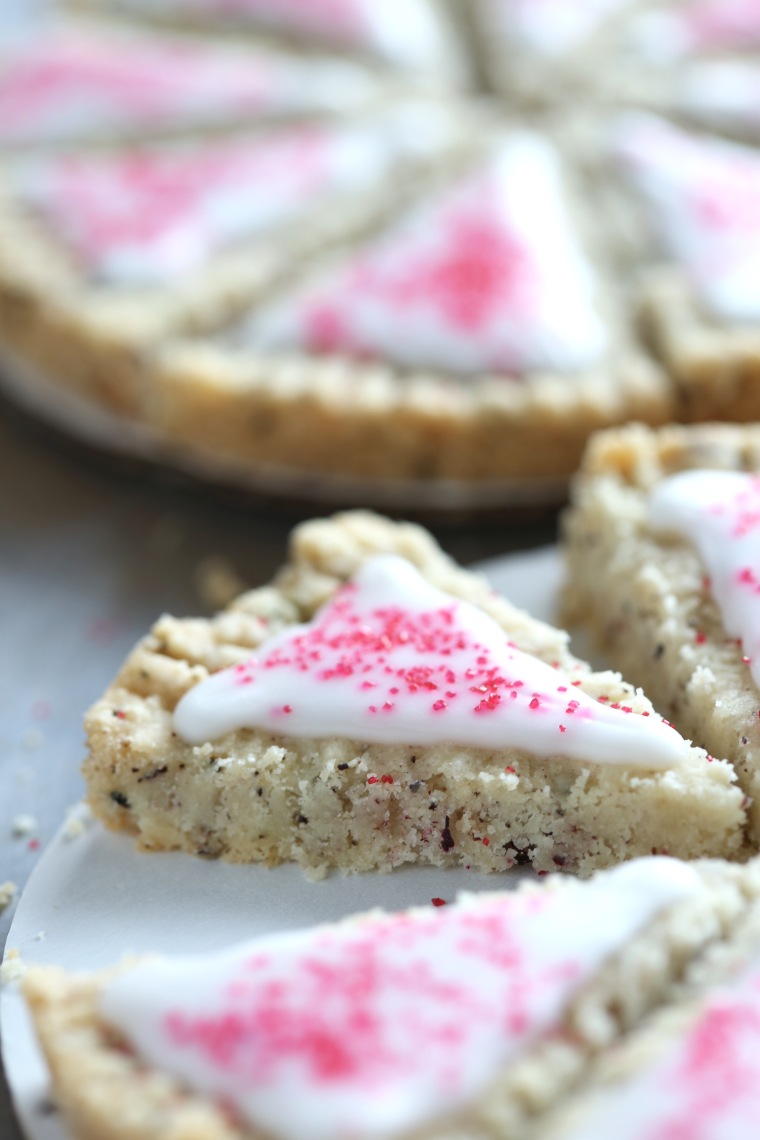 The recipe does not call for much tea so I only used a few calyxes-whizzed them in the spice grinder. My thought is that next time, and there will be a next time, I will use double the amount. After all, summer is coming and I will have more plants in the garden!
The recipe does not call for much tea so I only used a few calyxes-whizzed them in the spice grinder. My thought is that next time, and there will be a next time, I will use double the amount. After all, summer is coming and I will have more plants in the garden!
 Join us sometime! We love the company. Pick up a copy of Baking Chez Moi and bake along with us. To see how the rest of the bakers did, visit the website.
Join us sometime! We love the company. Pick up a copy of Baking Chez Moi and bake along with us. To see how the rest of the bakers did, visit the website.
 Vintage cookbooks are often a treasure trove of information, especially if you want to know the history of a recipe. If you flip through some, you may come across recipes for Green Goddess Dressing, a classic creamy dressing that gets its color from the herbs that are pureed into the mixture. If you have an herb garden that is producing large quantities of parsley, tarragon and chives, this may just be the recipe for you.
Vintage cookbooks are often a treasure trove of information, especially if you want to know the history of a recipe. If you flip through some, you may come across recipes for Green Goddess Dressing, a classic creamy dressing that gets its color from the herbs that are pureed into the mixture. If you have an herb garden that is producing large quantities of parsley, tarragon and chives, this may just be the recipe for you.
For this recipe, I turned to my copy of Helen Brown’s West Coast Cook Book, a 1952 reprint published by the Cookbook Collectors Library. In the headnote for the recipe, she names The Palace Hotel (presumably the one in San Francisco) as the source and the creators of the dressing. According to Ms. Brown, it was created in honor of the actor, George Arliss and the opening of the play The Green Goddess by William Archer.
 My copy of the book is a reprint but I love the graphics of this version! This printing does not include any other drawings or photographs in the recipe and I have not ever seen one with a dust jacket but if you are lucky enough to find a copy of the original printing, it may have the dust jacket. Either way, if you enjoy the Mid-Century Modern style of cooking, I recommend picking up a copy, it is full of great recipes!
My copy of the book is a reprint but I love the graphics of this version! This printing does not include any other drawings or photographs in the recipe and I have not ever seen one with a dust jacket but if you are lucky enough to find a copy of the original printing, it may have the dust jacket. Either way, if you enjoy the Mid-Century Modern style of cooking, I recommend picking up a copy, it is full of great recipes!
 The Palace Hotel’s Green Goddess Dressing
The Palace Hotel’s Green Goddess DressingMakes about 3 1/4 cups-can easily be cut in half or thirds
8-10 filets of anchovies (I only used 3)
1 green onion, chopped
1/4 cup minced fresh parsley
2 tablespoons minced fresh tarragon
3 cups mayonnaise (I used half mayonnaise and half buttermilk so that it would be thinner)
1/4 cup tarragon vinegar
1/4 cup chopped fresh chives
She instructs the reader to mince the anchovies with the green onion and then combine all of the ingredients in a bowl that has been rubbed with garlic. To make my batch of dressing, I combined it all in the blender and pureed until smooth and no chunks of anchovies were visible, and I omitted the fresh garlic but you could easily add some if you like. Keep it in the fridge, it lasts about a week but after that, it starts to get a little fishy from the anchovies.
A few notes:
The dressing has a tendency to thicken and gel after it sits in the fridge, I used buttermilk to lighten it and add a little tang. After refrigeration, it will need to be stirred so that it pours.
Be sure to use fresh herbs for the best flavor and texture, a perfect excuse to plant a few in pots and keep them on the window sill or the garden.
Using a blender makes the dressing smooth, if you prefer, you can mince the ingredients as finely as possible and whisk the dressing together. You could also use an immersion blender but I would skip the food processor because of the small amounts of herbs and anchovies.
When I began gardening seriously, I found myself focusing on herbs. Medicinal herbs, culinary herbs, ornamental herbs; it didn’t matter, I had dreams of using as many as possible to fill the beds at the Demonstration Garden. In my search for plant sources, I came across the Well Sweep Herb Farm in Mount Bethel, New Jersey. When the catalog would arrive in my mailbox, I would study it, make lists, and dream of the garden that would be some day. Along with that dream was the idea that one day, when I was in the area, I would get to visit the farm and that day came recently when I discovered that it was less than an hours drive from my mother’s home. We set off on a cool, fall morning and followed many winding, hilly country roads while enjoying the foliage display of the season and thanks to some very clearly marked roads and good directions, we arrived at the farm.
The owners of the farm live in a house at the front of the property and at first glance, you might think it is a bed and breakfast or an inn. The farm is open to the public year round so if you decide to visit, I suggest going back in a different season, the grounds are beautiful and there is plenty to see.

The formal herb garden is full of plants of all kinds and even though most plants are done for the year, there was still many that were putting on a display.
The foliage in the hills is spectacular this year and it made for a beautiful background at the farm.
There are fruit trees all over the farm and this one is amazing; look at that hole in the trunk. How it has survived and still seems to flourish.
All over the property you will find beds and focal points that mix a wide variety of plants.
Red Barns, split rail fences and bird houses dot the landscape.
There is more to see besides herbs on this farm and we walked past a few sheep grazing in this small pasture.
When you arrive at the farm, you are immediately aware of the presence of chickens because the roosters crow continually. We were intrigued by the long tail feathers and asked about them. Apparently, they raise Onagadori, Japanese long tail chickens.

The green and blue feathers and a tail that can be over 20 feet long make these birds very unusual in comparison to domestic chickens.
As we walked the grounds, we stopped to admire the blooms of this plant and found this sleeping bee.
Orange calendula in bloom near the greenhouse
No idea what this plant is, but the cottony fluff that is actually the seed was intriguing.
Annual Clary Sage putting on a show. The pink tops were eye-catching and this plant has earned a spot on my garden wish list.
Seed pods from Clematis vines, they look like pinwheels. An important part of landscaping is planning your plants so that there is visual interest for all the seasons and plants with interesting seed pods is a great way to accomplish that. The flowers may be gone but the seed pods provide interest and if left in place, they can lead to more plants, a win-win in my book!
After walking the grounds, taking photos, picking two plants (elderberry and a bearfoot hellebore), a pair of herb books and some garlic bulbs, we headed back towards home. For me, it was a chance to visit a garden I had seen in photos, crossing off one on the bucket list and then putting it back on the list; I hope to come back in another season-there are spring and summer to consider…
